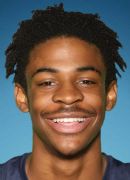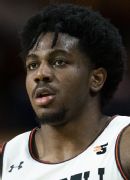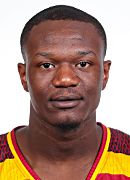Welcome back to our latest rankings of the top 25 players in college basketball. You'll never guess Nos. 2-25.
A certain rather well-known player (get well soon, sir) has made the rightful owner of the No. 1 ranking a less hotly disputed topic than in years past. So be it. There are still things to be learned about that player and certainly still news to be spread about other amazing performances.
Just a reminder that NBA-agnostic player evaluation is the name of this game. We'll leave the mock drafts and fretting about future potential to others. This is how players would be ranked on present-tense college impact only.
Enjoy ...

1. Zion Williamson, Duke Blue Devils
The story so far: Zion Williamson was doing Zion Williamson things, and then his shoe failed him. Hopefully the knee injury that resulted is, as Mike Krzyzewski said, a "mild sprain." Ideally, Williamson will return to the floor soon and at full speed.
As to these "Zion Williamson things" that we hope to see again in the very near future, some specificity is in order. Williamson is historically great at getting opportunities at the rim. The last time these top 25 rankings appeared, this fact was highlighted, quantified and celebrated.
Well, it's still true. In fact, Williamson's numbers were inching upward since we last convened to gawk at the havoc he can wreak in the paint. Shooting 75 percent on 2s as a 20-points-a-night scorer doesn't just come out of nowhere.
Allowing for the fact that we don't even know what we don't know regarding shot location back in the old days (it would be nice to see Bill Walton's 1972-73 rendered in this form), one might still hazard to say it's likely no player in the 3-point era has attempted so many shots so close as often as Williamson.
If anything, Williamson was being penalized statistically, ever so slightly, for the "do something spectacular" expectations that were heaped upon him. Specifically, his dunk percentage is, relatively speaking, underwhelming. The Duke freshman has converted 52 of his 58 attempted dunks this season.
That's a bit on the low side (see, for example, Rui Hachimura: 46-of-46, not to mention the vertically privileged Tacko Fall: 58-of-58), and it very likely speaks to the fact that when it was Williamson who was on a breakaway, the lad was expected to at least attempt a 720-degree windmill backflip dunk while eating a cupcake topped by a lit candle.
Were he merely a force of historically high-volume 2-point-scoring nature for a national title contender, it would probably be enough to land Williamson at No. 1 on this list. Add in the fact that he owns the highest steal rate of any player during the ACC conference season and is a partner in shot-blocking and shot-altering mayhem with Marques Bolden, however, and you're confronted with a basketball unicorn. Get well soon, Zion.

2. Ja Morant, Murray State Racers
Let's hear it for Morant's teammates. After all, a potential No. 2 or 3 overall pick as a point guard in the 2019 draft doesn't just lead the nation in KenPom assist rate at Murray State without some help. We see you knocking down those open 3s, Tevin Brown. Way to convert in the paint, Shaq Buchanan and Darnell Cowart.
At the same time, the first commandment for any competent floor general is to identify the best option on each play, and that option is very often Morant himself. The 6-foot-3 sophomore draws about seven fouls per 40 minutes, and he's shooting 81 percent at the line. That accuracy on free throws paired with Morant's willingness to let it fly from beyond the arc, by the way, suggests that his 33 percent 3-point shooting could well improve given sufficient time.
One thing to watch going forward will be turnovers. Morant has given the ball away 41 times in the past 413 MSU offensive possessions when he's been on the floor. (He is pretty much always on the floor, of course.)
Nevertheless, the question for armchair coaches everywhere might not be as simple as it first appears. Just how much treadmill time should coach Matt McMahon really give to his nationally celebrated scoring point guard who, yes, committed nine turnovers against Eastern Kentucky but also dished 14 assists, pulled down 8 rebounds, recorded 3 steals and put up 25 points? Reasonable observers will differ on that answer, but a franchise near the top of the lottery is likely to look at all of the above and conclude, yeah, we'll take our chances.

3. Brandon Clarke, Gonzaga Bulldogs
When Gonzaga is playing its conference schedule, it's kind of like the scene in "Apollo 13" when the spacecraft is orbiting around the far side of the moon and has temporarily lost radio contact with mission control. Hoops nation says, in effect, we'll catch you on the flip side in March, Bulldogs.
Well, hoops nation, that's a mistake. The Zags collectively, and Clarke individually, are continuing to do rather remarkable basketball things. By the first week of February, to take one example, the 6-foot-8 junior had already broken the program's single-season record for blocked shots. Not bad for a player shooting a near-Zion-like 70 percent on his high-volume 2s.
Perhaps it will require confirmation from March, but what we've seen thus far merits at least a provisional sum-up: Clarke is, to this point in the season, in the conversation as the best Gonzaga player of the past decade. Given the program that Mark Few has built, that's saying something.

4. Markus Howard, Marquette Golden Eagles
College basketball could use a Game of the Year award for players, if for no other reason than a decade or so of those winners gathered into one highlight spray would be outstanding. If this soon-to-go-viral idea is adopted in time for a 2018-19 awards ceremony, Howard will definitely be in the hunt for this honor.
In Division I competition this season, the 5-foot-11 junior's 53-point explosion against Creighton in January was bettered only by Cameron Young's 55-point effort on behalf of Quinnipiac against Siena. Howard drained 10 shots from beyond the arc that day in Omaha, and his ability to make opponents pay on the perimeter with 43 percent 3-point shooting has been on display for the entire season. No mere spot-up shooter, Steve Wojciechowski's star is a versatile threat on 3s, 2s and at the line alike. Howard's best entry in the Game of the Year competition might still be forthcoming.

5. PJ Washington, Kentucky Wildcats
The scary thing about Washington's 23-point performance on 9-of-12 shooting against what was then No. 1-ranked Tennessee isn't that it was such a good game, though it was. No, the remarkable part is that his performance against the Volunteers felt so representative and customary. This is what Washington does now, and he's running out of spots to climb higher on this list as a result.
At 6-foot-8, Washington has assumed the role of Kentucky's featured scorer as a nominal stretch-4. He averages one made 3 per contest and commands respect from opponents by shooting an excellent percentage from out there, but he's most dangerous in the paint. Again, ask the Vols: Washington wore out Rick Barnes' team on the interior, to the tune of 8-of-10 shooting on his 2s. The sophomore's season numbers say a relatively low 53 percent of his 2-point attempts are recorded at the rim, but that might be changing before our eyes, making Washington, if anything, even more dangerous.

6. Ethan Happ, Wisconsin Badgers
Happ's virtues as a hybrid post scorer and voluminous manufacturer of assists have become familiar to the point of being taken for granted. It bears repeating, then, that the 6-foot-10 senior accounts for a higher percentage of his team's assisted baskets while he's on the floor than do Josh Perkins, Ty Jerome, Tre Jones or Carsen Edwards. We'll be waiting a long time before we see so many assists from the nation's third-most-prolific per-game source of 2-point makes.
Greg Gard's star is one of the best players in the country when the clock is running. When it's not, however, the struggle has become, if anything, more pronounced. Happ has missed his last 10 free throws and is shooting 33 percent at the line in Big Ten play. When and if this is cured (paging Rick Barry?), the renaissance man on offense who's also an outstanding defensive rebounder will be very, very close to the proverbial complete player.

7. Grant Williams, Tennessee Volunteers
It's difficult to pigeonhole a reigning SEC player of the year who has actually improved year-to-year in almost every facet of his game, but let's try. For starters, Williams is having what can only be termed an amazing season shooting 2-point jumpers, runners and every other kind of attempt that's inside the arc but not at the rim. That type of shot is, of course, supposed to be a low-efficiency quagmire, and defenses are increasingly happy to allow them.
But letting Williams shoot those non-rim 2s is looking more and more like a mistake. Tennessee's star is getting better than a point per attempt from those tries, at a time when he's also better than he was last season at the line, on the defensive boards and at distributing the ball. There's no guarantee Williams will repeat as POY in the SEC, but it's looking increasingly likely that 2018-19 will, in fact, clock in as his better all-around season.

8. Cassius Winston, Michigan State Spartans
For three seasons now, Winston has been among the national leaders in assists. In fact, a robot programmed to track only that number probably would conclude the junior is the same as he ever was. But the truth is that Tom Izzo's 6-foot-1 point guard has transformed his game and become the go-to scorer on one of the nation's most dangerous offenses.
Winston will want to emphasize that "go-to scorer" part even more strongly now that Nick Ward has been sidelined indefinitely because of an injured hand. The junior has always been able to hit 3s (this is a player who shot 56 percent from beyond the arc against Big Ten opponents last season), and now he's doing so at a higher volume than ever while also getting to the line more often. MSU is not at 100 percent without Ward (not to mention without Josh Langford), but as long as Izzo has Winston, the Spartans will be heard from in the Big Ten title race.

9. Mike Daum, South Dakota State Jackrabbits
The next time someone references the transfer "epidemic," remember Mike Daum. He has been at the same stand in Brookings, South Dakota, now for four seasons and 123 games and counting. It is likely opposing coaches in the Summit wouldn't have been terribly distressed had he decided to explore opportunities at major-conference programs.
Make no mistake, those opportunities existed for the Dauminator. Instead, the senior is poised to lead the Jackrabbits to a fourth straight NCAA tournament. Daum has always scored with an equal degree of remorseless efficiency from both sides of the line (he'll get that bothersome perimeter slump in Summit play squared away) and, at 6-foot-9 and 235 pounds, he's a career 85 percent shooter at the line on more than 800 attempts.

10. Carsen Edwards, Purdue Boilermakers
If you're looking for evidence of Edwards' impact, this is one instance where individual stats (which in this case are, of course, excellent) might lead us slightly astray. Simply put, Matt Painter has never given as heavy a workload on offense to any previous player as he has this season to Edwards. Caleb Swanigan, Isaac Haas, AJ Hammons, Robbie Hummel, JaJuan Johnson, E'Twaun Moore, even Carl Landry himself -- none of those guys carried the number for possession usage that Edwards is showing in 2019.
Point being, a Purdue offense with Edwards as its sun and its moon is working beautifully. The Boilermakers could end the season with the Big Ten's best offense in league play, thanks to good 3-point shooting, a low turnover rate and plenty of offensive boards. Edwards is driving the first (Ryan Cline's open looks are somewhat correlated to defenses being preoccupied with a certain teammate) and especially the second of those factors.

11. Caleb Martin, Nevada Wolf Pack
Martin checks in alongside some pretty elite company nationally, yet he might not even win player of the year in the Mountain West or even on his own team. He'll receive strong competition for both honors from Jordan Caroline, who's having a great medium-volume year shooting 3s and who does the dirty work for the Wolf Pack on the glass. Put it this way: Debating which 6-foot-7 senior is more deserving of accolades is a really nice problem for Eric Musselman to have.
One note to be sounded in Martin's favor in such discussions is that he is the most effective overall option on offense for a Nevada team that's dominating the MWC with its defense but is running neck and neck with Utah State for the title of most-efficient scoring in conference play. The senior from North Carolina averages 19 points and does so with an individual turnover rate low enough to be felt at the level of team performance. In other words, it's no mistake Musselman's guys have the lowest team turnover percentage in MWC play.

12. Ty Jerome, Virginia Cavaliers
This seems to be a bit of a golden age for teams that excel as cohesive player-republics and largely without any readily identifiable "stars." Michigan, Kansas State and Houston could all win their respective conference titles while fitting this description fairly well. Virginia, too, has often been classed this way. That said, Jerome is having one really nice season as part of the Cavaliers collective. He is again hitting 3s and harassing opposing ball handlers while serving as first among five equal UVA decision makers. Take, for instance, the heartily well-deserved raves Kyle Guy earns for that crazy-quick release of his. Those releases are very often preceded by a half second by the receipt of still another pinpoint Jerome pass.

13. Dedric Lawson, Kansas Jayhawks
It didn't used to be like this, but Lawson currently suffers from one of the more lopsided public-attention-to-player-performance ratios of any player on this list. Back in the halcyon days of December, when Udoka Azubuike and Marcus Garrett were still on the court and people were thinking in terms of a Kansas national championship, the Memphis transfer was receiving an appropriate measure of acclaim. But now that the Jayhawks are shorthanded and everyone thinks Bill Self will "just" (ha) win the Big 12 again and nothing more, the 6-foot-9 junior has fallen off some radar screens. Feels a bit unjust for a player whose numbers are holding steady or even improving (Lawson's making 3s now) despite the aforementioned teammate disappearances.

14. Rui Hachimura, Gonzaga Bulldogs
If Brandon Clarke is putting up rather astounding numbers, and he is (see above, up there near Zion-territory), part of that credit surely goes to Hachimura as well. The junior is, after all, the leading scorer for a national title contender that laptops are saying repeatedly and with increasing impatience is one of the best teams we've seen in the past five years, period. Opposing defenses have customarily been helpless to fend off the twin Gonzaga terrors in the paint, and the evidence to date suggests Hachimura becomes even more prominent in the Bulldogs' offense as the quality of the opponent improves.

15. Jarrett Culver, Texas Tech Red Raiders
There's a case to be made that fans, writers, coaches and humans in general are hardwired to overreact at least a little when one player goes missing because of injury or some other cause. But if Texas Tech ever had to do without Culver, well, that might be a different matter. The 6-foot-6 sophomore is the best option for made shots, assists, drawn fouls and low-turnover ball possession on a Red Raiders team with an immaculate defense and a so-so offense. He could be a 2019 lottery pick, and it's conceivable there's an "aha" moment coming soon, where we'll see Culver playing against defenses that can't single him out so relentlessly.

16. Matisse Thybulle, Washington Huskies
Basketball has long had a problem with measuring individual player defense, and there will never be a better chance to get this issue squared away once and for all than with Thybulle. He's dominating games in ways that are elusive in or even invisible to box scores, and it's not clear if cameras and tracking sensors can fully capture the futility and desperation of opponents, either. The reigning Pac-12 defensive player of the year should be in line for the 2019 conference POY trophy with no "defensive" modifier attached, period. If there's a player in this league who has a greater impact on a game than Thybulle, they have not yet made their presence known.

17. Jarron Cumberland, Cincinnati Bearcats
Cumberland has made 17 3s in his past four outings, and it was his 27 points at Houston that made the home team work so hard before finally putting away the Bearcats 65-58. At 6-foot-5, the junior functions as both Mick Cronin's leading scorer and best source for assists on a very high-shot-volume offense. (Contrary to the UC stereotype, the offense has been superior to the D in conference play.) His relatively low success rate on 2s can perhaps be seen as a job not so much for better shot selection as better shot location. Again, Cumberland is hitting 43 percent of his 3s on the season. Move those 2-point jumpers back a step or two, and all will be well.

18. Tremont Waters, LSU Tigers
The strength of this LSU team is its offense, and the best feature of the Tigers' attack on that end of the court is its 5-foot-11 sophomore point guard. Waters had a stretch spanning November and December where turnovers were an issue, but don't be misled by those particular season numbers. In SEC play, he has been slicing up opposing defenses with assists, drawn fouls and/or conversions on drives to the rim in roughly that order. Waters is also the lead ball hawk on a defense where he vies for that honor with the likes of Skylar Mays and Ja'vonte Smart. His 36-point eruption at Texas A&M ranks as one of the best individual performances the SEC has seen this season.

19. Coby White, North Carolina Tar Heels
There was a time when North Carolina looked down on 3-pointers as newfangled and suspicious, but no longer. Indeed, the Tar Heels' signature skill on either end of the court in ACC play has arguably been draining shots from beyond the arc, keeping in mind Roy Williams' guys are attempting nearly as many 3s as an average team in the conference. This embrace of the 3 has been led by White and Cam Johnson, with White additionally serving as the capable leader of the break for a UNC team that in conference play is faster paced, both in absolute and relative terms, than any rotation Williams has had since the 2009 national champions.

20. Chris Clemons, Campbell Fighting Camels
On a list where everyone has crazy numbers, Clemons very possibly has the craziest numbers. The nation's leading scorer is on an even more select list than this one -- an NCAA career-scoring roster with Pete Maravich at the top. Clemons now ranks No. 9 on that list, a 3,000-point-plus showing powered in part by this season's average of 29.8 points per contest. Speaking of this season, Kevin McGeehan's senior is drawing nearly eight fouls per 40 minutes and ranks No. 3 in the country in that category. Clemons will want to keep putting the ball in the basket, however: South Dakota State's Mike Daum (see No. 9, above) is not far behind on the career scoring list.

21. RJ Barrett, Duke Blue Devils
Embrace the paradox: Barrett is right there alongside a certain teammate in owning some of the best single-game performances of any Duke player this season, starting with the triple-double against NC State. Granted, triple-doubles can be fetishized at the expense of other meritorious deeds unburdened by arbitrary cutoffs. Still: 23 points to go along with 11 rebounds and 10 assists? From a 6-foot-7 freshman? That'll do. If anything, Barrett was even more impressive in the Blue Devils' first win against Virginia, scoring 30 points powered by 10-of-13 shooting inside the arc against statistically one of the best defenses of recent years.

22. Daishon Smith, Louisiana Monroe Warhawks
The most dedicated college hoops fan remembers Smith making 12 starts for Gregg Marshall in 2016-17 and then becoming the only player to depart from an otherwise intact Wichita State roster that was expected to return and do big things in 2017-18. (Those Shockers ended up earning a No. 4 seed and losing in the round of 64 to Marshall.) Now, two years later, the 6-foot-1 Smith is fairly running amok for an occasionally overmatched Warhawks team. He scored 42 points in a January game against Little Rock and, in a recent two-game stretch against Georgia State and Georgia Southern, he poured in 74 points on a mere 41 shots from the field. His across-the-board accuracy on 3s, 2s and the line (42, 52 and 90 percent, respectively) allows Smith to do a fair approximation of Buddy Hield in the Sun Belt.

23. Marial Shayok, Iowa State Cyclones
Shayok has reportedly envisioned posting a so-called 50-40-90 season, shooting those percentages on 2s, 3s and at the line. That doesn't look as if it will happen, but the senior is not off by much. (For one thing, Shayok is No. 1 at the line in Big 12 play, shooting 91.7 percent.) More important, the Virginia transfer has blended in perfectly with an Iowa State way of operating on offense, one that affords a player freedom as long as he takes care of the ball and makes wise choices on shot selection. In his one season in Ames, Shayok is leading the Cyclones to what should be a very nice seed in the tournament.

24. Justin Wright-Foreman, Hofstra Pride
If you're not watching Wright-Foreman, you're missing a good show. The 6-foot-2 senior has already put up 30 or more points nine times in 2018-19, and those points are being scored efficiently. (In just his past three outings, Wright-Foreman is 23-of-26 at the line.) After sustaining a 16-game win streak from November to February, the Pride fell at Northeastern and now stand at 12-2 in CAA play. There's a fair chance Hofstra will reach the field of 68 and, if so, set aside time to watch Wright-Foreman, the nation's third-leading scorer.

25. Antoine Davis, Detroit Mercy Titans
So, again, the story so far: Antoine Davis is historically great at making 3s. In fact, if the freshman played enough games, which he probably will not, Steph Curry's single-season record from 2007-08 would be in real trouble.
Speaking of which, can we get a standardized number of games in this sport? Like, well, every other sport ever? It could make records more well-known and the pursuit of them more avidly followed. Short of that, avidly follow Davis this way ...
If you remember 3-point whiz Marshall Henderson at Ole Miss a few years back, the UDM freshman this season is both making 3s at a much more accurate rate (39 percent) while doing so at a measurably higher per-game volume. So, yes, you should pull for the Titans to make it to the final game of the NCAA tournament, the NIT or basically any postseason. All Davis needs is enough runway.
